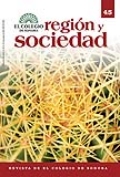 |
 |
 |
 |
 |
 |
 |
 |
 |
 |
 |
 |
Abstract
This article deals with human development within the Mexican states of Sonora, Baja California and Baja California Sur. Four indexes were estimated: human development with gross domestic product, services, gender, and inequity. In addition, quality curves were calculated for states and municipalities. Although Baja California Sur shows the best results in terms of human development indicators, followed by Sonora, Baja California ranks highest in the country in terms of equity.
References
Aguirre Valdés, Jesús. 2004. Estimación del índice de desarrollo humano 2000, para las entidades federativas de México, usando un PIB ajustado. Tesis de maestría en Economía del Desarrollo Rural. Universidad Autónoma Chapingo.
Anand, S. y Amartya Sen. 1995. Gender Inequality in Human Development: Theories and Measurement, Human Development Report Office Occasional, Paper no. 19. Nueva York: PNUD.
Bardhan K. y S. Klasen. 1999. UNDP'S Gender–related Indices: A Critical Review. World Development (27): 985–1010.
COPLAMAR. 1983. Necesidades esenciales en México. Situación actual y perspectivas al año 2000. Vol. 5, Geografía de la marginación. México: Siglo XXI.
DEMYC. 2003. Memoria técnica de los informes nacionales de desarrollo humano. División de Ciencias Forestales, Universidad Autónoma Chapingo, http://www.chapingo.mx/dicifo/demyc/idh/bases/memo/memoria.html (25 de agosto de 2008).
FORMUJER. 2003. Género y formación por competencias: aportes conceptuales, herramientas y aplicaciones. Montevideo: Centro Interamericano para el Desarrollo del Conocimiento en la Formación Profesional/Organización Internacional del Trabajo.
Gobierno de Sonora. 2007. http://www.sonora.gob.mx (15 de julio de 2007).
INEGI. 2000. Conteo de población y vivienda, XII Censo general de población y vivienda (XII censo), el BIE y BSIMBAD. http://www.inegi.gob.mx (12 de febrero de 2002).
––––––––––. 1995. Conteo de población y vivienda 1995, XI Censo general de población y vivienda, el BIE y SIMBAD. http://www.inegi.gob.mx (12 de febrero de 2002).
Korsgaard, Christine. 1996. Comentario a ¿Igualdad de que? y a Capacidad y bienestar. En La calidad de vida, compilado por Martha C. Nussbaum y Amartya Sen, 84–94. México: Fondo de Cultura Económica.
Palacios, J. 1983. El concepto de región: la dimensión espacial de los procesos sociales. Revista Interamericana de Planificación XVII (66): 56–68.
Pettinato, S. 2002. A Conceptual Primer on the Currents and Trends in Inequality. Journal of Human Development (3): 23–56.
PNUD. 1995. Informe sobre el desarrollo humano. Nueva York: UNDP–Oxford University.
––––––––––. 1990. Informe sobre el desarrollo humano. Nueva York: UNDP–Oxford University.
Pressman, S. 2000. The Economic Contributions of Amartya Sen. Review of Political Economy (12): 89–114.
Ramírez, Alejandro. 1999. Índice de desarrollo humano del estado de Guanajuato. Revista del Centro de Desarrollo Humano de Guanajuato AC (3): 9–28.
Sen, Amartya. 1993. Capacidad y bienestar. En La calidad de vida, compilado por Martha Nussbaum y Amartya Sen. México: Fondo de Cultura Económica.
––––––––––. 1987. The Standard of Living. En The Standard of Living, editado por G. Hawthorn, 1–38. Cambridge: Cambridge University Press.
UNDP. 2008. Human Development Report 2007/2008. Nueva York: UNDP. Mc Millan. http://hdr.undp.org/en/media/hdr_20072008_en_complete.pdf (22 de junio de 2008).
UNDP. 2002. Human Development Report. Nueva York: UNDP–Oxford University, http://hdr.undp.org/reports/global/2002/en/pdf/com–pletenew.pdf (25 de enero de 2002).
Zamudio S., Francisco J., J. L. Romo y J. C. Morales. 2006. Análisis comparativo del desarrollo humano en los estados de Sinaloa y Chihuahua. 1995–2000. región y sociedad XVIII (35): 43–73.
––––––––––, Mónica Pérez M. y Carlos Vargas T. 2002. Segundo informe sobre desarrollo humano de México: análisis comparativo del desarrollo humano en el lustro 1995–2000. México: Universidad Autónoma Chapingo–Centro de Desarrollo Humano de Guanajuato, A. C.
––––––––––. 2001. Primer informe sobre desarrollo humano de México 1995. México: Universidad Autónoma Chapingo–Centro de Desarrollo Humano de Guanajuato, A. C.
Open access policy
The authors who publish in región y sociedad accept the following conditions:
In accordance with the copyright laws, región y sociedad recognizes and respects the authors’ moral rights, as well as the ownership of property rights, which will be transferred to the journal to disseminate the articles in open access. región y sociedad does not charge the authors for submitting and processing articles for publication.
All the texts published by región y sociedad —with no exception— are distributed under a Creative Commons license 4.0 Attribution – Noncommercial (CC BY-NC 4.0 International), which allows third parties to use the publication as long as they mention the works’ authorship and the first publication in this journal.
The authors can enter into independent and additional contractual agreements for the nonexclusive distribution of the version of the article published in región y sociedad (for instance include it into an institutional repository or publish it in a book) as long as they clearly indicate that the work was published for the first time in región y sociedad.
For all the above, the author(s) must send the Letter of transfer of property rights of the first publication duly filled in and signed by the author(s). This letter can be sent by e-mail as a PDF to: region@colson.edu.mx






